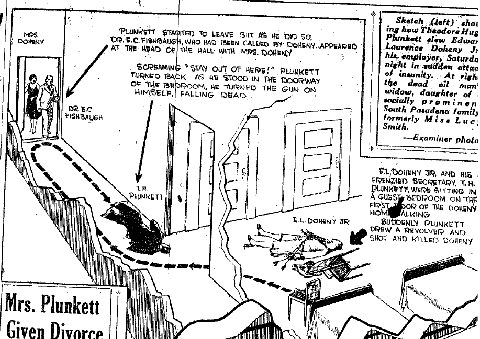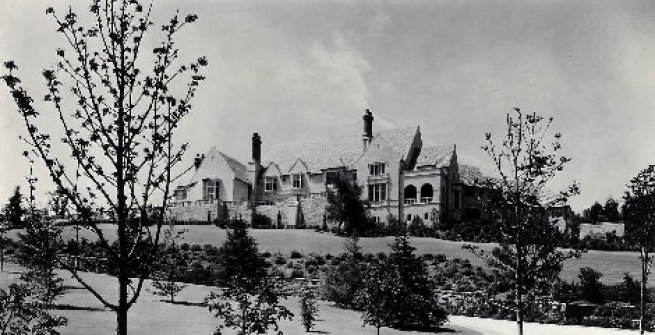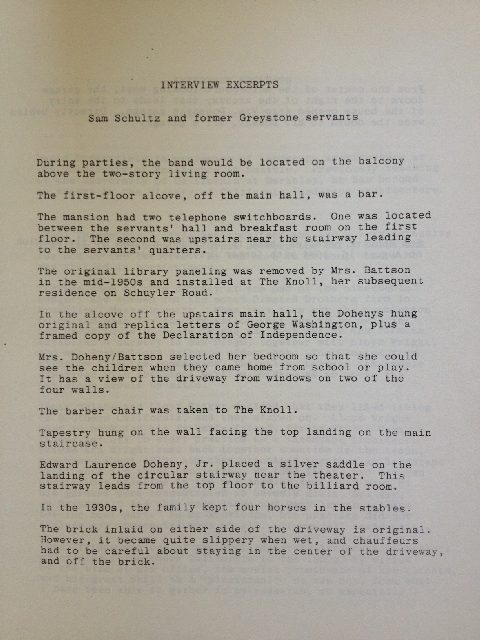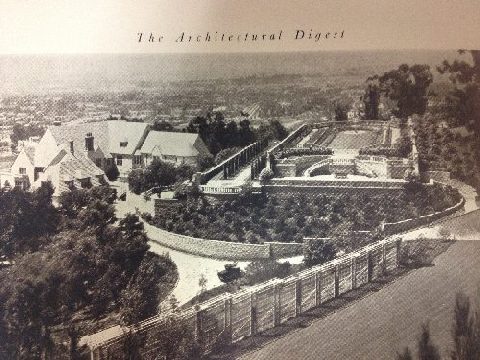I first learned of the Doheny Greystone tragedy while curating an exhibition of manipulated photographs taken from the library’s Herald Examiner photographs. While searching the extensive photo archive I came across a compelling black and white image that seemed an oddly cartoonish mistreatment of the 1929 event, which was described in the corresponding caption as a murder-suicide.

My memory faintly recalled the existence of a Greystone Mansion in Beverly Hills, but I did not know anything about its occupants or making. I was able to find a sufficiently concise history of the Doheny family and the construction of the property online via the non-profit historical organization, the Friends of Greystone:
"Edward Laurence Doheny, the original proprietor of the Greystone land, was born in 1856 in the small Midwestern town of Fond du Lac, Wisconsin. By the time he was a young teen, Doheny’s adventuresome spirit and love of the wilderness led him to prospect for gold and, soon thereafter, oil. In 1892, Doheny and his friend Charles A. Canfield were the first to strike oil in Los Angeles.
Edward Doheny and his wife Carrie Louella Wilkins had two children. Their first, a daughter Eileen, passed away when she was just seven years old. On November 6, 1893, their only son, Edward “Ned” Laurence Doheny, Jr., was born and grew up as heir to one of the world’s great financial empires. Ned went on to marry Lucy Smith of Pasadena, and in 1926, Edward Laurence Doheny Sr. gave his son as a wedding gift a premium parcel of land consisting of 12.58 acres with sweeping citywide views."
And several websites gave various accounts of that night’s fated events, this one from the Doheny Reference Center at USC:
"On the night of February 16, 1929, Hugh Plunkett arrived at the Greystone mansion. He called the house from the gates and was told by Lucy Doheny that he should not come in. Ignoring her words, he apparently used his pass key to enter the grounds and the house, going to the guest bedroom on the first floor where he often stayed. Ned Doheny found him there around 10 p.m. At 10:30 p.m., the Doheny family physician. E.C. Fishbaugh, who was in Hollywood attending a theater performance, received a call from his maid, who told him that he was needed urgently at the Doheny home. Fishbaugh arrived a little before 11 p.m. and was greeted by Lucy Doheny, who told him that Plunkett and her husband were in the guest bedroom. As they proceeded down the hallway to the bedroom, they saw the door standing ajar and Plunkett standing by it. He warned them to come no closer, then shut the door. Immediately after, a shot rang out. When the doctor entered the room, he found Plunkett lying on the floor by the door, shot through the head, the gun lying by his side. Doheny lay on the floor by the beds, next to an overturned chair, barely alive with a gunshot wound to the head."
The Internet provided a slew of theories regarding the murder-suicide, but only a few of these sites offered any reliable citations. Additionally, none of them offered access to the articles they did cite.
I decided to conduct a search in our California Index for more information and found that Charles Lockwood Peter Persic wrote a rather comprehensive historical report on the Greystone mansion in 1984. This document, available as a PDF online, includes a historical chronology of the estate’s history and construction, a cost summary and even interview excerpts from former employees:
Unfortunately, many of the appendices were missing; the sixth appendix in particular, included: “actual issues of the LA Times from the late 1920s with articles about Greystone and Edward Laurence Doheny, Jr’s death.”
Luckily, the full run of the LA Times is available online through our website. Using this database, I was able to find a good number of articles written about the murder-suicide shortly after it occurred. Sifting through these articles, I became curious to see how the photo I first stumbled upon was printed and contextualized in the pages of the Los Angeles Examiner, which the library carries on microfilm. While I was not able to find the original photograph, I did come across another illustrated reenactment of how the night unfolded:

I also did a quick search in our online catalog for published titles:
Unreal Estate: Money, Ambition, and the Lust for Land in Los Angeles by Michael Gross
The Doheny Mansion: A Biography of a Home Mary Ann Bonino
Stars, Moguls, Magnates: The Mansions of Beverly Hills Michael Regan
Lastly, I took a peek inside the California vertical file labeled "Residences, Beverly Hills, Greystone"—which I also found using the California Index. This vertical file contained several hard-copy articles, including a clipping from a feature in Architectural Digest (VII:1, 1929):
It was only after going through the last pages of every acidic article in the vertical file that my curiosity was finally entombed!
Fun fact: L.A.-based artist Kerry Tribe made a film based on all the different historical accounts of the Doheny murder-suicide titled Greystone. The film was shot on the Greystone property in the very rooms where the killings took place. The dialogue for the film was appropriated from the various Hollywood films that were shot at the mansion, including The Disorderly Orderly (1964), Witches of Eastwick (1987), and There Will Be Blood (2007), among others.


